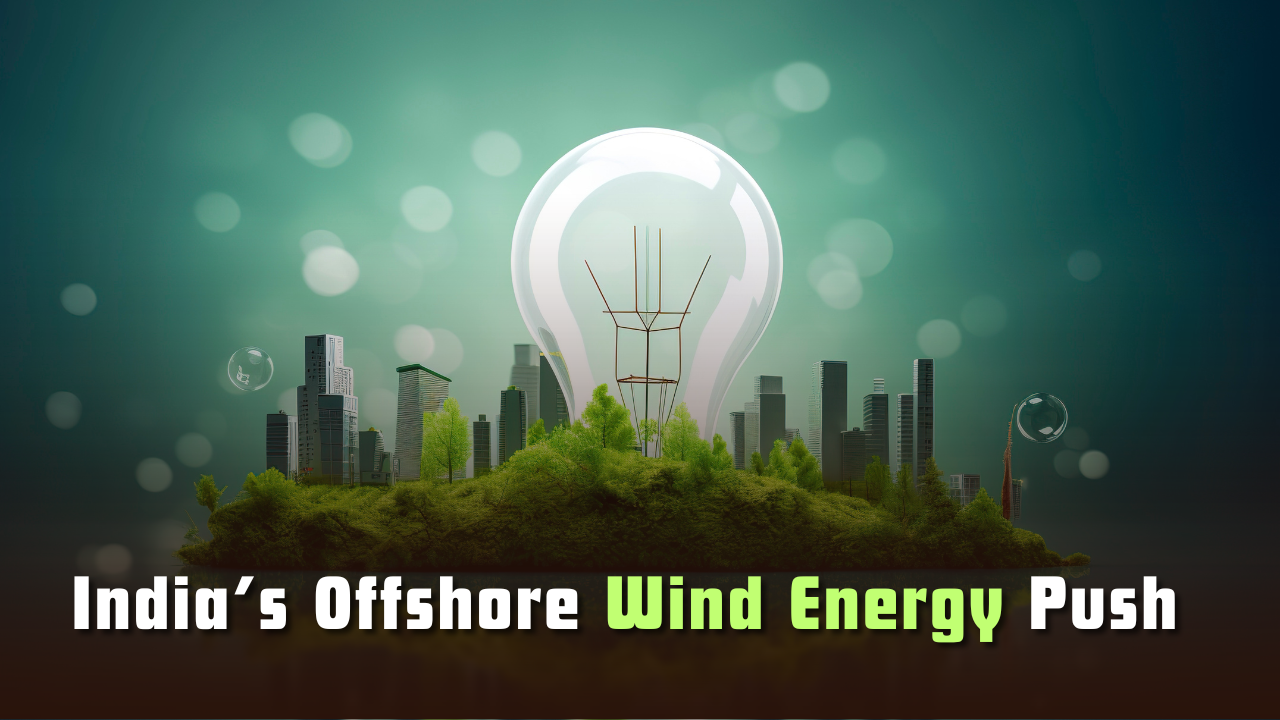Font size:
Print
India’s Offshore Wind Energy Push
Harnessing India’s Potential in Offshore Wind Leasing
Context: Amidst surging energy demand and increasing climate obligations, India is intensifying its focus on offshore wind energy to diversify its renewable energy mix and ensure round-the-clock (RTC) green power.
Why Offshore Wind?
- Offshore wind refers to renewable energy harnessed from wind projects installed within Exclusive Economic Zone (EEZ) waters, transmitted to ports, and purchased by states or distribution companies.
- India’s Offshore Wind Energy Goals & Capacity: India aims to install 30 GW of offshore wind capacity by 2030. The country has a commercial potential of over 70 GW in offshore wind energy.
Regulatory Architecture: A Legal Tailwind
- India’s National Offshore Wind Energy Policy sets the foundation for auctioning 37 GW of offshore site leases by FY 2030.
- The Ministry of New and Renewable Energy (MNRE) Strategy Paper identifies eight promising zones along Gujarat and Tamil Nadu coasts for offshore wind development.
- Three Development Models for Offshore Wind Projects:
- Model A (1 GW): Developers bid to construct 0.5-1 GW projects in Gujarat and Tamil Nadu within four years.
- Model B (14 GW): Developers get two-year exclusivity over seabed for surveys, followed by competitive bidding for site lease allocation with Viability Gap Funding (VGF).
- Model C (22 GW): Developers bid for project development or seabed allocation without VGF after completing surveys.
- Offshore Wind Energy Lease Rules (December 2023):
-
- Developers secure fixed-term seabed lease agreements from the Central Government.
- Lease areas range from 25 to 500 sq km, with entry restrictions for offshore wind activities.
- Maximum lease duration: 35 years (initial three-year lease for surveys, extendable by two years).
- Lease fee: INR 100,000 per MW (wind projects), INR 50,000 per MW (transmission), and INR 100,000 per sq km annually.
Security, Environmental & Data Provisions
- National Security & Environmental Protection: Government can assume operational control or appoint an agency if activities threaten security or cause environmental damage.
- Coastal Livelihoods: Fishing activities permitted within offshore wind farms if they do not interfere with operations.
- Data Security & Surveillance: Data sharing restricted to project execution with Naval Integrated Headquarters approval. Offshore assets in the Arabian Sea and Indian Ocean must provide real-time surveillance data to the Navy and Coast Guard.
Technical & Infrastructural Challenges
- Space Needs: 1 GW requires 250–400 sq km seabed.
- Depth & Size: Projects may require installation at ~57 m depth with large rotors and heavy infrastructure.
- Transmission Responsibility: CTU/STU to handle onshore power evacuation. Offshore corridors need dedicated monitoring and security.
- Technology Adaptation: Offshore turbines: 6–12 MW vs onshore 2 MW. Customisation is needed due to wind variations between Gujarat & Tamil Nadu.
- High Tariff Risk: Offshore tariffs are expected to be 80% higher than onshore.
Financial Support & Incentives
- VGF Sanction: ₹7,453 crore, including ₹600 crore for port upgrades.
- ISTS Waiver: 25-year exemption for projects commissioned before 2033. No surcharge for projects supplying to open access consumers before Dec 2032.
India’s Offshore Wind in the Global Energy Landscape
- China leads offshore wind deployment, commissioning 46.1% of new capacity in 2023. Holds over half the global offshore wind capacity, with 41 GW connected to its grid.
- Asia-Pacific Expansion: Bangladesh, Vietnam, South Korea recently introduced offshore wind projects.
- India’s Renewable Energy Growth: 25 GW added in 2024-25, marking a 35% increase from 18.57 GW in 2023-24. Solar dominates new installations, but offshore wind diversification is crucial.
- India ranks third in total energy consumption and fourth in wind power capacity.
- Accelerating offshore wind deployment is essential for India’s net-zero commitments and maintaining strategic weight in the global energy landscape.
- International collaboration: The third phase of EU-India Clean Energy Partnership in 2026 will focus on wdwwwwwwwwwwwwwwwwwwwind and green hydrogen.Carbon Trading: Potential integration with Article 6.2 of the Paris Agreement for added revenue.
- Shipbuilding Subsidy: 20% capital subsidy for specialised vessels (transport, maintenance, cable laying).
Lessons from Global Offshore Wind Markets
- Competitive Leasing Models: US, Netherlands, UK, Germany employ competitive auctions and bilateral bidding.
- Open-Door Model: Denmark pioneered this approach, allowing developers to submit lease applications freely. Temporarily suspended due to EU regulatory review.
- UK Contracts for Difference (CfD) Model: Demonstrates that direct investment programmes are powerful incentives.
- Stakeholder Compensation Models:
- UK’s Dogger Bank: Fisheries Liaison Officer ensured dialogue, funded alternative moorings, and real-time catch monitoring.
- Taiwan’s Formosa-I: Set up a fund for retraining and local job quotas, offering a CSR and co-benefit scheme template for India.
Subscribe to our Youtube Channel for more Valuable Content – TheStudyias
Download the App to Subscribe to our Courses – Thestudyias
The Source’s Authority and Ownership of the Article is Claimed By THE STUDY IAS BY MANIKANT SINGH


